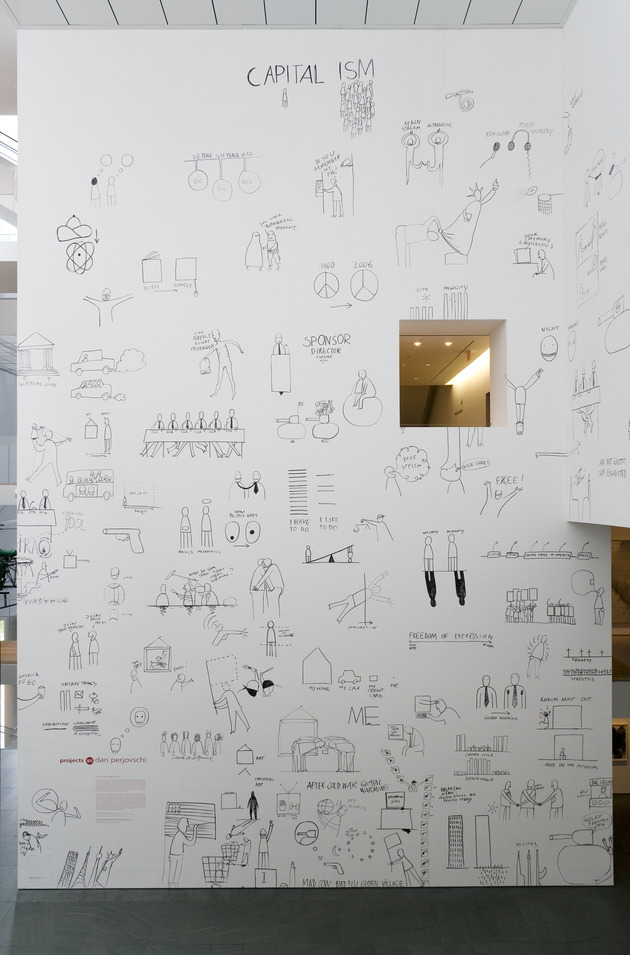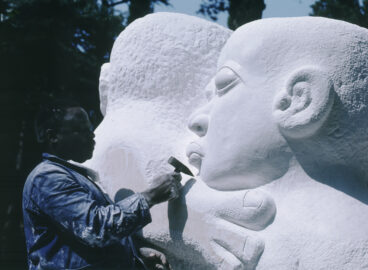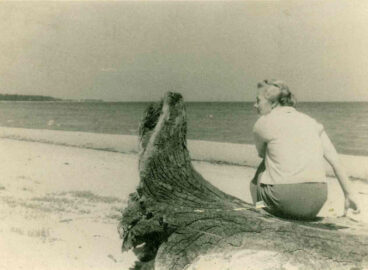A major new publication, Art and Theory of Post-1989 Central and Eastern Europe: A Critical Anthology, presents key voices of this period that have been reevaluating the significance of the socialist legacy, making it an indispensable read on modern and contemporary art and theory. The publication offers a rich collection of texts and an additional, reexamining perspective to its 2002 sister publication, A Sourcebook for Eastern and Central European Art since the 1950s, part of MoMA Primary Documents publications. For this new book, a series of conversations were commissioned with artists in the region and members of the C-MAP research group for Central and Eastern Europe at MoMA. The following is one of those dialogues, between MoMA curator and the book’s co-editor Roxana Marcoci and artist Dan Perjovschi.
Read a review of the publication at Hyperallergic.

Roxana Marcoci: In 1996, during my visit to Bucharest, you and Lia Perjovschi staged the first Open Studio, an interdiscursive forum with artists, curators, and scholars. Did you conceive of the Open Studio to function as an alternative exhibition space? I recall seeing there an installation of costumes that Lia used in her performances.
Dan Perjovschi: After 1989 we were suddenly in the situation of replacing outdated, impoverished, and conservative institutions. Lia and I were the “art institution.” For fifty years, Romania was cut off from the rest of the world. When we first started to travel, we did not only travel to New York, Paris, or Kassel but also through contemporary art history, through the 1950s, ’60s, ’70s, ’80s, and ’90s that we did not know (in my art education I barely reached Picasso). It was a fantastic journey. And Lia and I used all our resources (a studio, both our careers) to disseminate the findings. This was the first stage of Lia’s Contemporary Art Archive. We collected stuff (catalogues, flyers, invitations, leaflets) and experiences (what we saw and sometimes how we participated in international projects) and then distributed it through one-on-one discussions or in group gatherings in our studio. The location of the studio was great, in the heart of the city, in the yard of the art academy. In time it became, without intention, a kind of alternative art education, because from each generation of students, some knocked on our door. The conditions were dismal (dust, common toilets, stray dogs, etc.), but we overcame them. We were young, we had energy, and the course of history had changed (fall of dictatorship, freedom of expression), which gave us power.
By 1996, we were in the second phase, organizing lectures and artist talks. We were the first to do so—you and Cristian Alexa, Mike Nelson, some designer from Stockholm, some PhD researcher from Berlin, etc. Remember? We used slides, clack-clack. It was also an underground training for locals on how to make a presentation, how to talk about your art, and also a source of different definitions and understandings of art mediums and practices. I look at the pictures now and see an eighty-year-old Ion Bitzan and some youngsters in their twenties. Our audiences consisted of artists, art critics, and journalists (no curators in the early 1990s). Cultural journalists of all ages came into our studio. We were very media friendly, and we took advantage of the fact that there were not many interesting art events around.
You have to imagine that the median income was about $200 per month then, and a ticket to fly to New York was $800. Not many artists or journalists had the opportunity to go see Walter De Maria’s Earth Room, for example. We were invited or got grants. So without funding we operated any way we could; if we found out someone was coming to town, we asked him or her to come give a lecture, stuff like that. Conversely, we also operated like an information center for journalists and art professionals who came to Romania. We used to do a crash course in Romanian contemporary art and the political situation for them. We had no fear. I remember one time an American delegation of journalists from the Chicago Tribune, New York Times, and ten other U.S. papers coming to our studio, and afterwards they went to meet the president of the country—ha ha.
When we did an Open Studio, it was a four-day open access to an artist context. We did not stage the studio as an exhibition space. We let the place be as it was: an environment of our ideas, a place no longer to produce art objects but to debate and discuss art. Some of our art was around (like Lia’s paper bodies), but it was more about communicating, meeting, exploring the fantastic potential of contemporary art-making. The Open Studios were enormously successful: we were on all the Romanian TV networks, and we even got a live show on National Public TV Channel 1. Crowds came—and stayed and stayed. We showed stuff, we discussed; a lot of ad hoc roundtable happened.
The practice of open studios came back only recently, as the dearth of exhibition spaces has forced artists to open their studios. But now it’s different; it’s more about the market and selling. Anyway, Lia has some huge panels with hundreds of photographs of these meetings with local and international artists and curators. Until 2005 we did a lot. A lot.
RM: Speaking of nonconformist strategies of display, I can think of exhibitions in which your work was presented exclusively in magazine and book formats, such as in the publications Revista 22, Idea, and Radical Museology, and you have also made drawing installations embedded in the fabric of a city and sketches that take shape directly on institutional walls—at Van Abbemuseum in Eindhoven and MoMA in New York, among many others. Can you speak about these exhibition setups and why are they relevant to your practice?
DP: For a long time I made my living doing drawings for various publications or designing book covers. I am in love with printed matter. For me the newspaper format is one of the best mediums—a four-, eight-, or sixteen-page gallery. I edit my own newspapers that I distribute for free during shows or re-exhibit in various contexts. I have about thirty. Books are another love story. I basically want to buy and have all the books. Every time I enter a great bookshop, I am in awe. For twenty-eight years of my life I barely had access to books due to censorship and lack of money. Now I try to avenge that.
At some point (as was happening with my newspapers) I realized that the book is a great format for my practice. I did several artist books, and more recently I’ve developed some project-books (such as the one with Claire Bishop). Actually, it all started with Claire asking me for some visuals for one of her conferences.
I am happy to participate in any book or magazine project. I love disseminating my drawings through these platforms. I have gotten requests form PhD researchers who want to use some of my drawings for the covers or interior spreads of their theses to make them more appealing. And I am talking about physics or medical PhDs. People google me, or they see my projects someplace and identify me by my drawings. Just look on Facebook how many of my drawings are used as profile images. I am very happy about all this archipelago of possibilities.
As for drawing on museum walls—well, this is a dream come true. I am still shocked and grateful that I can do this practice. Freestyle. Go and draw whatever I want on museum walls. Fantastic! I use any square meter as a platform for free expression, criticism, and empathy about the complicated world we live in. I draw black and white but with many colorful ideas.
RM: Your witty, poignant drawings and texts focus on issues such as migration, war, capitalism’s one percent, and cutting funding for the arts. As an artist who is an activist, as an activist who is also a journalist, and as a journalist who amplifies the voice of institutional critique, what types of exhibition spaces have proved to be the most progressive in your estimation?
DP: Roxana, I love every space where I am free to express—museums, art centers and galleries, newspapers, books, libraries, and now Facebook. Big museums have big audiences, mixed audiences, family audiences, and international audiences. Small artist-run institutions and galleries have art-focused audiences. Facebook is global, newspapers have their own public, and public space is for everybody (at the São Paulo Biennial, my intervention in the local subway was seen by more people than the biennial itself). I love them all. You know, I am given a kind of wild card; the curator and the museum director do not know what I will draw—neither do I. It’s a trust business. I love this freedom (and the responsibility that comes with it). And because my work is more or less displayed in interstitial spaces (lobbies, stairwells, corridors, glass-walled entrances), my installations are more or less freely accessible; sometimes they are even viewable from outside, such as the outdoor wall at Kunsthalle Basel. The Tate’s exclusive Members Room was open to everybody because of my project. At MoMA, everybody going to see the Richard Serra retrospective had to pass in front of my wall. (Thanks, Richard!)
I like this distribution of my art and my statements in these in-between spaces. It gives my art a broader meaning, not only within art history but also within activism and—do not laugh—revolution. In the last five or six years I became (due to social media) a sort of drawing provider. People staging a demonstration against the brutal reality of a city, people fighting to save a park, or a Roma-related human-rights group will ask me for a logo or for drawings to be placed on banners. I’ve done a lot of this stuff, and there is quite a feeling when you see the main boulevard in Bucharest occupied by people carrying one of my drawings. I’ve said this several times: I am not an activist, but my drawings are.
RM: In 2001, the Romanian government created the National Museum of Contemporary Art (MNAC), and in 2004 the museum moved into a newly constructed wing of the Palace of the Parliament, which was built during the Ceauşescu regime to house the entire administrative apparatus of the state in one enormous building. Due to its controversial location, MNAC quickly became one of the most divisive contemporary art spaces in Eastern Europe. Can you elaborate as to why this was the case?
DP: In general there are problems with all contemporary art museums in Eastern Europe due to their monopoly (one museum per country) and political context. The best model in the region is the Moderna Galerija in Ljubljana, which has focused on artist archives and has a regional (not national) collection. Getting back to your question regarding MNAC, Lia and I have never stepped foot in that monster. You know there is a huge empty space around that building, which for the past twenty-seven years has been closed to the public, like a private park; the building is like an island circled by a wall. You need five thousand bodies to make a human chain around this wall, and in twenty-seven years, it was done twice: once to demand access to the communist-era secret service files, and the second time to protest against a massive gold mine that would have razed four mountains and left us with the biggest lake full of cyanide in Europe. That protest marked the biggest citizen uprising since the Romanian Revolution. In both cases, contemporary art was not on the side of justice and the people but on the side of corrupt power—inside there, over the wall.
This sheds light on the intellectual condition of an institution born of corrupt power and inhabiting one of the ugliest and most oppressive of buildings.
I think twelve years after its inauguration, the museum shows its limitations due to its physical location, which as a place where the people have been evicted and is now home to a corrupt parliament, is inextricable from its place in the public psyche. It is an isolated place in the middle of town carrying so much historical weight that nobody can escape it; some “critical” shows have even become intellectual kitsch. The huge space in the parliament building is just part of a monopoly on art spaces. MNAC owns the beautiful Sala Dalles, also located in the middle of town. It’s a marvelous space that has been misused for years to get extra money (rented out for various consumer-goods-related fairs or without a proper exhibition program). MNAC also owns the Anexa, a four-story industrial warehouse converted into a place for young artists’ art (capitalizing on a rough postindustrial look), and it also has some dedicated galleries at the renovated National Theatre in central Bucharest. MNAC is a dominating monster, leaving galleries and artist-run spaces the size of a napkin. Well, size matters, but it can also squash you—just imagine paying the bill to heat those spaces in minus twenty degree Celsius, which isn’t uncommon in Bucharest in winter. And that building is the parliament. Imagine if the U.S. had only a single contemporary art museum, located in the Capitol with a Republican majority.
The supreme irony here is that the most hated building in Romania has become, over the course of twenty-seven years, heavily promoted by the political power as the embodiment of a national genius in architecture and art. There are forty postcards and numerous fridge magnets featuring the Ceauşescu Parliament Palace. So the building that emptied the refrigerators of our citizens (they paid with hunger and freezing in their apartments) is now occupying the fridge.
Well, I hate that, and I do not want to be represented by MNAC. I refuse it. I boycott it. I make it small and insignificant. I do not show there, I do not sell works to it, I do not collaborate with it—I never step foot in it. Fuck it, and fuck them.
RM: Ten years ago, Romania became an official member of the European Union. How has this shift impacted the reception of contemporary Romanian art? How has the institutional landscape change in the last twenty years? And can we still speak today of “Eastern European” art exhibitions?
DP: At the critical or theoretical level, we can argue, but at the level of art production and budgets, yes, there is still a gap. There is still an invisible wall. Well, if you look at Hungary, there it is not so invisible. As a whole, the East collapsed in the market. The discussion is no longer about freedom but about the collections. Less artist-run spaces, more commercial galleries (and some spectacularly successful ones). There are several new contemporary art museums that have opened in Eastern Europe, but all of them face budget shortages and crushing missions (to research, preserve, restore, collect, and internationally promote their national art). It is a huge mission because in some cases these institutions are alone (one per country) and face reactionary politics (again, Hungary).
For me as an individual, but also for the exchange of art and goods, and the free movement of people, the EU was a blessing. I travel without a visa. I think my projects quadrupled because of this reality.
There is more and more equality in the way we make art, show it, and how we understand it. And this makes me, an artist born, educated, and living in Romania, feel at home in New York, Trondheim, Hong Kong, or São Paulo.


